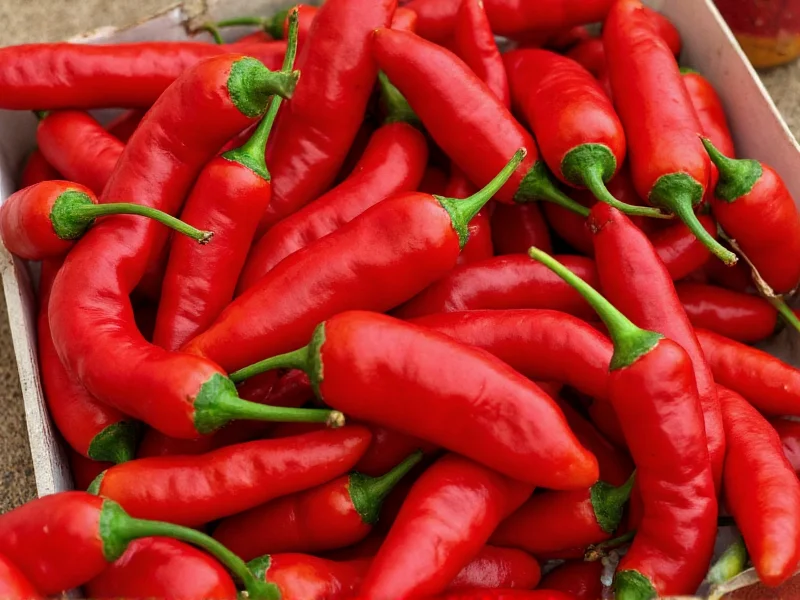Pasilla chiles, the dried form of fresh chilaca peppers, are a staple in Mexican cuisine known for their complex flavor profile rather than intense heat. Understanding their precise heat level helps home cooks and chefs incorporate them effectively into recipes without unexpected spiciness.
Understanding Pasilla Chile Heat Measurement
The Scoville scale measures chili pepper heat by determining capsaicin concentration. Pasilla chiles register between 1,000–2,500 Scoville Heat Units (SHU), which places them significantly milder than many popular peppers. For context, this heat level means pasillas deliver gentle warmth rather than intense burn, making them accessible even to those with moderate spice tolerance.
Pasilla Chile Heat Compared to Other Popular Peppers
| Pepper Variety | Scoville Heat Units (SHU) | Heat Level Comparison |
|---|---|---|
| Pasilla | 1,000–2,500 | Mild to medium |
| Poblano (fresh) | 1,000–1,500 | Slightly milder than pasilla |
| Jalapeño | 2,500–8,000 | Noticeably hotter than pasilla |
| Serrano | 10,000–23,000 | 4–10x hotter than pasilla |
| Habanero | 100,000–350,000 | 40–140x hotter than pasilla |
Factors That Influence Pasilla Chile Heat
Several variables affect the actual heat level you might experience with pasilla chiles:
- Growing conditions - Soil composition, climate, and water availability impact capsaicin production
- Maturity at harvest - Fully mature chilacas develop more complex flavors with moderate heat
- Drying process - Properly dried pasillas maintain consistent heat levels while developing richer flavor
- Individual variation - Like all natural products, some variation exists between peppers
Flavor Profile Beyond the Heat
While understanding how hot are pasilla chiles is important, their culinary value extends far beyond heat measurement. These dried peppers offer:
- Earthy, raisin-like sweetness
- Subtle smoky notes from the drying process
- Complex berry undertones
- Rich umami depth that enhances sauces and stews
This multidimensional flavor profile explains why pasilla chiles remain popular despite their modest heat level. Chefs value them for adding complexity rather than just spiciness to dishes.
Culinary Applications for Pasilla Chiles
Knowing exactly how hot are pasilla chiles helps determine their best culinary uses:
- Mole sauces - Their moderate heat won't overpower other ingredients
- Stews and braises - Adds depth without excessive spiciness
- Marinades - Infuses meats with flavor without overwhelming heat
- Salsas - Provides background warmth in cooked salsas
When rehydrating pasilla chiles for recipes, remember that soaking them in hot liquid extracts both flavor and heat. For milder results, remove seeds and membranes before soaking.
Common Misconceptions About Pasilla Heat
Several misunderstandings persist about how hot are pasilla chiles:
- Misconception: Pasillas are very hot because they're used in Mexican cuisine
Reality: Many traditional Mexican dishes use pasillas specifically for flavor, not heat - Misconception: All dried chiles are extremely hot
Reality: Drying concentrates flavor but doesn't necessarily increase heat proportionally - Misconception: Pasillas and poblano peppers have identical heat levels
Reality: While related, dried pasillas typically run slightly hotter than fresh poblanos
Substituting for Pasilla Chiles Based on Heat Preference
If you're adjusting recipes based on how hot are pasilla chiles, consider these substitutions:
- For milder heat: Ancho chiles (1,000–2,000 SHU) or guajillo (2,500–5,000 SHU) with reduced quantity
- For similar heat: Mulato chiles (2,500–3,000 SHU) which share flavor characteristics
- For more heat: Combine pasilla with a small amount of chipotle or arbol chile
When substituting, remember that different chiles contribute unique flavor elements beyond just heat, so the final dish may vary in complexity.
Practical Tips for Working with Pasilla Chiles
Maximize your experience with these versatile peppers:
- Toast dried pasillas lightly in a dry skillet before rehydrating to enhance flavor
- Remove seeds and white membranes for milder results when using how hot are pasilla chiles in sensitive applications
- Store dried pasillas in an airtight container away from light for up to one year
- Reconstitute in hot water, broth, or even beer for added flavor dimension
Conclusion
Understanding how hot are pasilla chiles (1,000–2,500 SHU) reveals why they're prized for flavor rather than heat. Their mild to medium warmth makes them versatile across numerous dishes, from complex moles to everyday salsas. By recognizing their position on the Scoville scale relative to other peppers, cooks can confidently incorporate pasillas into recipes knowing exactly what heat level to expect while appreciating their distinctive earthy, smoky flavor profile.
Are pasilla chiles hotter than jalapeños?
No, pasilla chiles (1,000-2,500 SHU) are milder than jalapeños (2,500-8,000 SHU). Pasillas provide gentle warmth while jalapeños deliver noticeably more heat.
What is the Scoville range for pasilla chiles?
Pasilla chiles measure between 1,000 and 2,500 Scoville Heat Units (SHU), placing them in the mild to medium heat category of peppers.
Can I substitute ancho chiles for pasilla chiles?
Yes, ancho chiles (1,000-2,000 SHU) make a good substitute as they have similar heat levels and complementary flavor profiles, though anchos tend to be slightly sweeter.
Why are pasilla chiles considered mild despite being used in Mexican cuisine?
Mexican cuisine uses many pepper varieties for flavor complexity rather than just heat. Pasilla chiles contribute earthy, smoky notes with only moderate warmth, making them versatile for traditional dishes where balanced flavors matter more than intense spiciness.











 浙公网安备
33010002000092号
浙公网安备
33010002000092号 浙B2-20120091-4
浙B2-20120091-4